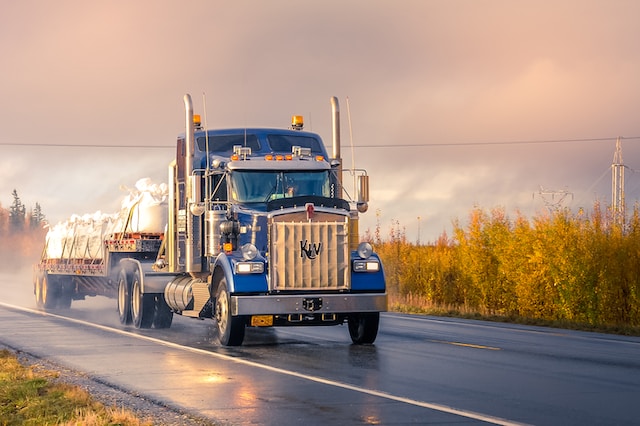The transportation of oversized loads requires specialized equipment and significant expertise that only a few flatbed trucking companies have. Unlike typical shipments, oversized loads can weigh over 200,000 pounds and take up multiple lanes of traffic. Dimensions exceeding 16 feet in width or 18 feet in height are not uncommon. For oversized transportation companies equipped to take on these massive shipments, the challenges are immense. From obtaining special permits across multiple states to carefully navigating undersized bridges and tunnels, rigorous planning and coordination ensure safe delivery. Exceptional drivers trained to maneuver long, heavy loads are mandatory. And when dealing with equipment like hydraulic trailers and removable goosenecks for hauling massive machinery and structures intact, there’s no room for error. For flatbed trucking companies, oversized loads demand an entirely different caliber of equipment, experience, and caution compared to standard freight shipments. This blog post explores those specialized capabilities in more detail.
Types of Oversized Flatbed Equipment
One essential trailer type is the removable gooseneck (RGN), which allows the bed to completely detach from the fifth wheel via a hydraulically operated gooseneck. This enables hauled equipment like excavators, bulldozers, and cranes to drive or be winched directly onto the trailer bed. Step decks are another important oversized flatbed trailer that features a lower deck height for easy loading. The deck then raises hydraulically to provide adequate ground clearance. Double drop trailers further enhance accessibility with both lower deck heights and overall platform heights. Flatbed trucking companies in Texas commonly rely on these trailer types along with standard flatbeds for hauling massive oil field equipment, wind turbine blades, yachts, and industrial machinery that exceeds regular load dimensions. Proper securement is critical with oversized flatbed equipment. Chains, heavy straps, specialized winches, and other hardware must be correctly rated and fastened to stabilize enormous payloads. The right oversized trailers, tools, and expertise keep these sensitive loads intact across long distances.
Considerations for Hauling Oversized Loads
A multi-state permit is crucial, but it can be a lengthy and complex process, especially for a multi-state route. Companies must ensure they work closely with permitting agencies and allow sufficient lead time. Finding qualified drivers with specialized training for maneuvering long, heavy oversized loads is also critical. Drivers must expertly navigate tight turns, low overpasses, and other obstacles that require exquisite precision. Careful route planning is a must to avoid features like narrow tunnels and bridges that could cause problems. Companies also need to coordinate with utility companies when power lines present an overhead clearance issue. Proper weight distribution and load securement using specialized equipment like hydraulic winches must be flawlessly executed. Flatbed trucking companies often bring on step deck brokers to source additional trailers like RGNs and double drops needed for the job. Police escorts and pilot vehicles are required for most oversized loads traveling public roads, so coordinating this through local law enforcement is vital. Overall, hauling oversized loads leaves no room for shortcuts or oversight. Advanced preparation and strict adherence to regulations enable expert carriers to take on these high-stakes shipments.
Challenges and Risks of Oversized Loads
When it comes to oversized loads, the margin for error is extremely narrow. Any mistake can easily lead to catastrophic accidents, damaged equipment, infrastructure harm, or complete shipment disruption. The logistical complexity itself poses immense challenges, as seemingly minor issues like an incorrectly permitted route or overlooked tunnel height can completely derail the transport. Proper load securement is exponentially more difficult with massive, awkward heavy equipment that can shift in transit if chains or straps aren’t perfectly fastened. Drivers have an incredibly difficult job maneuvering long trailers with extreme precision along narrow routes and backing them into tight spaces. Low overpasses and other clearance obstructions are a constant concern. Even when meticulous planning and preparation occurs, oversized loads involve substantial risks and obstacles at every turn. Companies taking on these shipments need extensive specialized experience to understand the pitfalls and handle any problems that arise. There’s no doubt oversized flatbed trucking requires the utmost skill and care – when loads worth millions of dollars and public safety are on the line, transporters must eliminate mistakes and reduce risks wherever possible. It’s a zero-tolerance environment.
Best Practices for Managing Oversized Loads
Companies hauling RGN loads Texas wide should institute rigorous maintenance routines to ensure equipment like removable goosenecks performs flawlessly. Ongoing education and training prepare drivers to expertly navigate oversized trailers in all conditions. Route planning software and satellite tracking help transporters select optimal oversized-friendly routes and monitor progress. Double-checking load securement points using proper procedures should occur before departing and at every stop. Carefully inspecting chains, straps, winches, and the load itself for shifting at stops prevents problems down the road. Cultivating strong relationships with permitting agencies across regions simplifies the approval process. Clear communication protocols ensure permitting timelines are met. Following these best practices enables flatbed trucking companies to minimize mishaps and deliver unwieldy oversized loads intact and on time. When you’re transporting multi-million dollar equipment or structures, there’s no room for mistakes. Diligent planning, top-notch equipment, and highly qualified drivers are must-haves.
Oversized loads are transported on flatbed trucks with specialized equipment, highly skilled drivers, and meticulous planning. Companies must implement rigorous protocols and utilize advanced technologies to ensure these unwieldy, high-value shipments arrive intact and on time. With little margin for error, experienced carriers take a proactive approach to load securement, route selection, clearance calculations, and more. When transporting oversized loads, reputable flatbed trucking companies always make safety the utmost priority. They proactively identify and mitigate any potential risks at each step of the process. This diligent, cautious approach enables them to deliver even the most unwieldy, sensitive oversized loads without incident.







